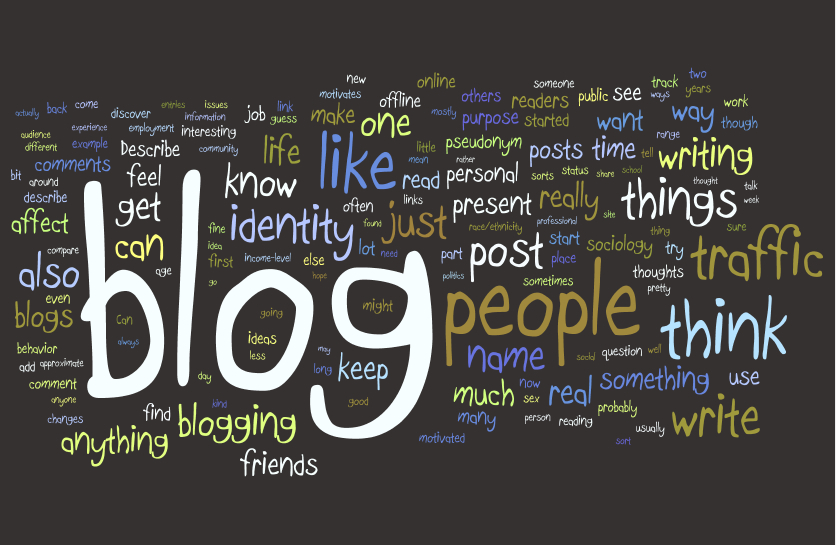 |
| Image courtesy of Flickr |
"Alright. I'm using
random.org to call you up for your blog conference. You'll have 4-6 minutes to go through the prompts I've given you. I'll have a computer up here already so you can walk me through your thinking. According to random.org, the first person is...."
Thus my
blog conferences, as described here, had begun.
Here is a list of my period 3 and 4 blogs, and I've included Hackney's period 7 blogs, too.
I am writing this post after my first day of conferences. My students (as Sean's would later in the day) began their conferences with me about how this semester of blogging has gone. Our
blog assignment sheet can be found here.
Essentially, we gave students their choice of blog platform--
Blogger,
Tumblr,
Wordpress,
Weebly,
Snack Websites--and had them post almost weekly in the genre we were studying for that two-week unit. For example, our curriculum includes a
Literacy Narrative as the first essay. Their first blog post had to be a narrative about something that happened to them on the job. If they never had a job, some students posted about trying to get one, and others wrote about summer work with their dad or mission work with their church. The blog was a chance to formatively practice the writing genre so that they could perform it better summatively. In terms of which blog platform they chose, most of my students used Tumblr, about a third used Blogger, and just a few used Wordpress or Weebly.
Not one of my students had been a blogger prior to this course. A few had a tumblr account but didn't really do anything with it. One girl told me today that she thought blogs "were just for responding to what other people said, like what my mom had to do for an online class she took in college."
Here is the
list of topics the students were assigned for blogging; they follow the writing progression for the course: Literacy Narrative, Annotated Bibliography, Single-text Analysis, Compare/Contrast, Literary Analysis, Multi-source Synthesis/Argument.
When the students wrote an argument essay, they had to blog about a cause on
change.org. Suddenly, they were activists petitioning others to sign on for a cause, to make change happen. One student told me today, "I had to get more people to look at the petition. My goal for next semester is to find out how to get more people to read my blog." The student used hashtags on his change.org post to get the petition viewed more frequently.
I had the students walk me through their journey of audience awareness. I asked them how their understanding of audience developed. I heard them say things like, "Well, at first, I knew it was just you, so I didn't care as much, but then when you had us start following others in the class, I was like, 'I don't want them to think I'm dumb,' so I tried harder." Another said, "The audience at first was you and the class, but then you showed us how to check our page views if we used Blogger, and people from around the world were viewing my blog. I felt like I had to be more interesting." And, my favorite, was this: "My goal for next semester is to make my blog more glowy and sparkly so more people read it and comment on it."
I took nothing they said as a personal attack; rather, I felt like a Physical Therapist talking to a patient about how the stretches made him feel (
it hurts when you move my arm like this, so don't do that). When I heard comments like, "I just couldn't connect to that post you made us write about that TED talk," or "That post in response to tipping from the
New York Times, I just didn't care. That set me back because I didn't have anything to say about it, so I was late on that one," it's those comments that I will use as formative feedback for my own teaching.
How can I improve this blogging experience next semester? Next year? For other teachers who ask me how it's going? How much will I control the topics and how much will I let them choose?
I know--because I've searched for the info myself--that there are thousands of blog posts about how to be a better blogger. About how to teach blogging. About how to make interesting posts. Well, I'm one semester in, so here's my humble addition to the existing literature about teaching with blogs:
- Make the posts occur regularly.
- Give them choices.
- Use the blogs as formative writing practice for summative writing assignments.
- Check in with them regularly.
- Get testimonials from previous students about the positives and drawbacks of the various blog platforms.
- Make them read each other's blogs.
- Use technorati.com, the blog search engine, to get them reading blogs.
- Conference with them.
- Grade them with care, because they care about being assessed on how they feel.
- Identify your tech wizards in class and empower them to help others.
- Create opportunities for kids to teach each other how to do make posts more interesting.
- Help them expand the audience: email the links to parents, other teachers, or other classes.
- Oh yeah, and write along with them. That's what got Hackney and I writing this blog in the first place.
I am open to all kinds of feedback on this, and please, feel free to open up my students' blogs in the link near the top and give them some feedback, too. We look forward to next semester when we can enrich this experience even more.


